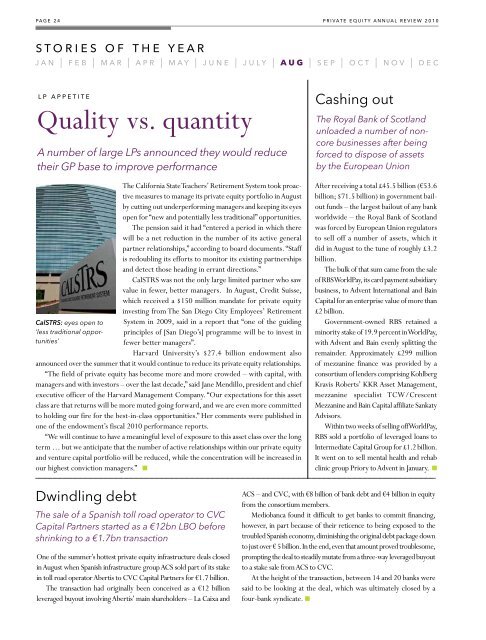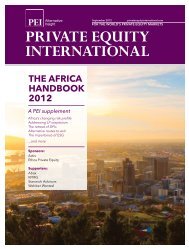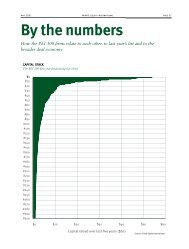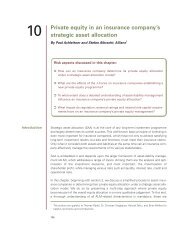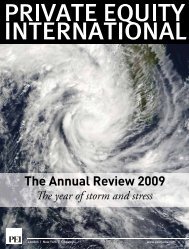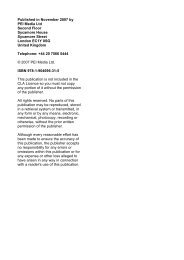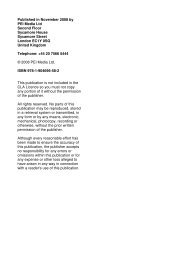THE ANNUAL REVIEW 2010 - PEI Media
THE ANNUAL REVIEW 2010 - PEI Media
THE ANNUAL REVIEW 2010 - PEI Media
Create successful ePaper yourself
Turn your PDF publications into a flip-book with our unique Google optimized e-Paper software.
page 24 private equity annual review <strong>2010</strong><br />
s to r i e s o f t h e y e a r<br />
j a n | f e b | m a r | a p r | m a y | j u n e | j u ly | a u g | s e p | o c t | n o v | d e c<br />
l p a p p e t i t e<br />
Quality vs. quantity<br />
A number of large LPs announced they would reduce<br />
their GP base to improve performance<br />
CalSTRS: eyes open to<br />
‘less traditional opportunities’<br />
The California State Teachers’ Retirement System took proactive<br />
measures to manage its private equity portfolio in August<br />
by cutting out underperforming managers and keeping its eyes<br />
open for “new and potentially less traditional” opportunities.<br />
The pension said it had “entered a period in which there<br />
will be a net reduction in the number of its active general<br />
partner relationships,” according to board documents. “Staff<br />
is redoubling its efforts to monitor its existing partnerships<br />
and detect those heading in errant directions.”<br />
CalSTRS was not the only large limited partner who saw<br />
value in fewer, better managers. In August, Credit Suisse,<br />
which received a $150 million mandate for private equity<br />
investing from The San Diego City Employees’ Retirement<br />
System in 2009, said in a report that “one of the guiding<br />
principles of [San Diego’s] programme will be to invest in<br />
fewer better managers”.<br />
Harvard University’s $27.4 billion endowment also<br />
announced over the summer that it would continue to reduce its private equity relationships.<br />
“The field of private equity has become more and more crowded – with capital, with<br />
managers and with investors – over the last decade,” said Jane Mendillo, president and chief<br />
executive officer of the Harvard Management Company. “Our expectations for this asset<br />
class are that returns will be more muted going forward, and we are even more committed<br />
to holding our fire for the best-in-class opportunities.” Her comments were published in<br />
one of the endowment’s fiscal <strong>2010</strong> performance reports.<br />
“We will continue to have a meaningful level of exposure to this asset class over the long<br />
term … but we anticipate that the number of active relationships within our private equity<br />
and venture capital portfolio will be reduced, while the concentration will be increased in<br />
our highest conviction managers.” ■<br />
Cashing out<br />
The Royal Bank of Scotland<br />
unloaded a number of noncore<br />
businesses after being<br />
forced to dispose of assets<br />
by the European Union<br />
After receiving a total £45.5 billion (€53.6<br />
billion; $71.5 billion) in government bailout<br />
funds – the largest bailout of any bank<br />
worldwide – the Royal Bank of Scotland<br />
was forced by European Union regulators<br />
to sell off a number of assets, which it<br />
did in August to the tune of roughly £3.2<br />
billion.<br />
The bulk of that sum came from the sale<br />
of RBS WorldPay, its card payment subsidiary<br />
business, to Advent International and Bain<br />
Capital for an enterprise value of more than<br />
£2 billion.<br />
Government-owned RBS retained a<br />
minority stake of 19.9 percent in WorldPay,<br />
with Advent and Bain evenly splitting the<br />
remainder. Approximately £299 million<br />
of mezzanine finance was provided by a<br />
consortium of lenders comprising Kohlberg<br />
Kravis Roberts’ KKR Asset Management,<br />
mezzanine specialist TCW/Crescent<br />
Mezzanine and Bain Capital affiliate Sankaty<br />
Advisors.<br />
Within two weeks of selling off WorldPay,<br />
RBS sold a portfolio of leveraged loans to<br />
Intermediate Capital Group for £1.2 billion.<br />
It went on to sell mental health and rehab<br />
clinic group Priory to Advent in January. ■<br />
Dwindling debt<br />
The sale of a Spanish toll road operator to CVC<br />
Capital Partners started as a €12bn LBO before<br />
shrinking to a €1.7bn transaction<br />
One of the summer’s hottest private equity infrastructure deals closed<br />
in August when Spanish infrastructure group ACS sold part of its stake<br />
in toll road operator Abertis to CVC Capital Partners for €1.7 billion.<br />
The transaction had originally been conceived as a €12 billion<br />
leveraged buyout involving Abertis’ main shareholders – La Caixa and<br />
ACS – and CVC, with €8 billion of bank debt and €4 billion in equity<br />
from the consortium members.<br />
Mediobanca found it difficult to get banks to commit financing,<br />
however, in part because of their reticence to being exposed to the<br />
troubled Spanish economy, diminishing the original debt package down<br />
to just over € 5 billion. In the end, even that amount proved troublesome,<br />
prompting the deal to steadily mutate from a three-way leveraged buyout<br />
to a stake sale from ACS to CVC.<br />
At the height of the transaction, between 14 and 20 banks were<br />
said to be looking at the deal, which was ultimately closed by a<br />
four-bank syndicate. ■


